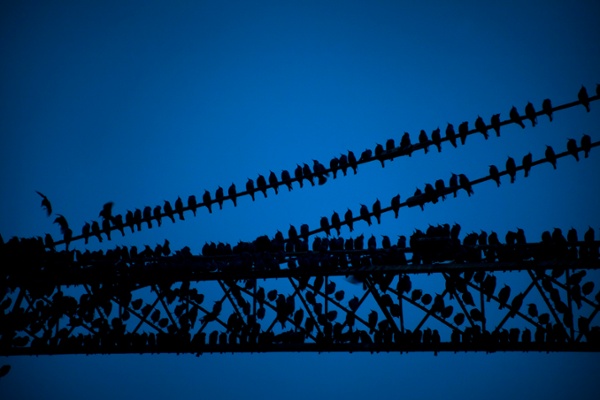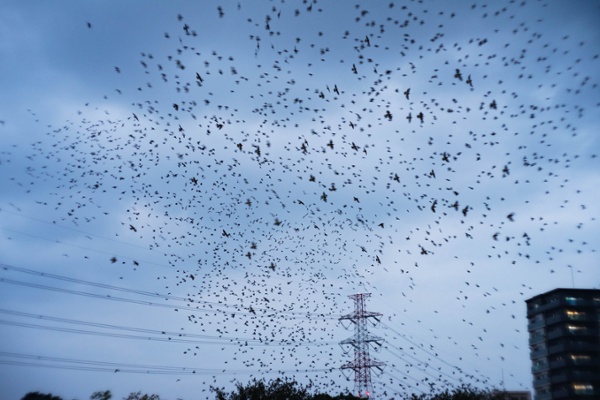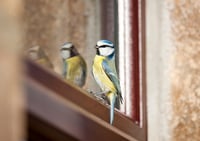
In 1890, 60 starlings were brought from the UK to New England. Within a few decades, their numbers had increased exponentially. With their current population somewhere between half a billion and one billion, starlings are a nuisance bird species that tends to wreak havoc wherever it goes. Read on to learn more about the threat that starlings cause, types of starling damage, and what you can do if you have a starling problem.
Identifying Starlings and Starling Damage
While there are many species of starling, the European starling is the most common species found in the United States. Roughly eight inches long, these birds are known for their metallic-tinged black plumage, though different subspecies may have different characteristics.
As opportunistic birds, starlings prefer to settle in urban or suburban areas. It makes access to food easier, and they tend to prefer to nest in trees or on manmade structures. Starlings are omnivorous and can adapt quickly to many habitats.
Though starlings do eat many problem bugs and help to control insect populations, the good they do is very much outweighed by the destruction they cause. Millions of dollars worth of damage to agriculture can be attributed to starlings each year.
Why Are Starlings Such a Problem?
Since their population is so huge, starlings can flock by the thousands, and starling damage can quickly reach a massive scale. A flock of this size can easily wipe out an entire vineyard or fruit orchard within just a few days. Though farmers may be able to scare off a few birds, the sheer size of their flocks makes them fearless, and it can be difficult to combat an army of starlings.
Between 1990 and 2001, 852 incidents of aircraft hazard were reported due to starlings. Birds can get sucked into engines, as was the case in 1960 when 62 people were killed on a plane that crashed when it collided with a flock of starlings and went down. Though birds tend to fly lower than planes do, they still pose a problem during takeoffs and descents.
In addition, they compete with native species like chickadees, nuthatches, swallows, and woodpeckers for prime nesting sites. Starlings can be aggressive when pushing other species out, which means that the starlings get a better opportunity to breed and propagate while other birds are left looking for other nesting sites.
These are just some of the general problems that starlings cause. But they can be a particular nuisance to homeowners and business owners alike.
What Damage Do Starlings Cause to Homes?
If starlings decide to call your property home, you may be in trouble. Homeowners often feel powerless to combat flocks of starlings on their own. Here are just a few of the problems they can cause for homeowners:
Garden Destruction
If you grow fruit, vegetables, or other crops on your property, a flock of starlings can eat all your hard work within a few hours. If you enjoy feeding native bird species, rude starlings may invite themselves to your feeder, clearing it out quickly.
Noise Problems
If you've ever woken up to the sound of one or two birds chirping at all hours of the morning, imagine the noise a flock of starlings can make. They're notoriously noisy and are expert mimics. They may mimic the sounds of other birds, car alarms, ringtones, or even human speech.
Nest Building
To keep their nests safe, starlings prefer spots like inside walls. Their nesting materials can easily clog gutters and pipes. They may also choose exhaust vents or ductwork, which can be a fire hazard.
Droppings Damage
Starling droppings can appear in huge quantities seemingly overnight if you are visited by a large flock. Droppings are acidic and can damage paint or deck stain. You may even need to call in a professional for cleanup.
If you notice a few starlings around your home, start by eliminating food sources and seal up potential nesting sites. Make your home as unattractive as possible to these birds so that they choose somewhere else to nest.
What Problems Do Starlings Pose for Business Owners?

Like homeowners, business owners face a number of problems due to starlings. One of the biggest problems is their droppings. Because they produce such a massive quantity of droppings in a short time, it can pose a health risk for patrons to your business. Droppings can be very slippery, and when dried, they can cause breathing problems.
In addition, starlings, like many pest bird species, carry disease. Their droppings carry bacteria, fungi, and parasites that can be a serious threat to public health. As mentioned above, their huge flock size means they can invade an area, making it an unpleasant place for people to be. Also, their aggressive nature may end up scaring people away.
What Are the Best Solutions for Preventing Starling Damage?
When you feel like you're in a constant battle with starlings, what steps can you take to curb their population? You can use repellents, deterrents, and traps to create a long-term management plan and get rid of your starling problem for good. Here are a few of the most helpful solutions:
Bird Netting
You can use netting like StealthNet to keep starlings out of enclosed or semi-enclosed areas like barns, balconies, garages, and more. This fine mesh netting creates a barrier that birds can't get through.
Block Ledges
If you find starlings roosting on walls or ledges around your property, use a product like BirdSlide to create a surface where they can't get a grip.
Optical Deterrents
Visual deterrents like shiny surfaces will make birds feel threatened. Try Eagle Eye, which reflects beams of light and can scare off starlings.
Auditory Deterrents
Speakers that mimic the sounds of predators or distress calls can make birds feel unsafe on your property.
As a last-ditch effort, you can also install traps, though it's recommended that you exhaust all other options first.
If you have a starling damage problem on your property, then stop it in its tracks with products from Bird Barrier. Our wide selection of deterrents, repellents, and traps can help make your starling problem a thing of the past. Contact us to learn more about how we can help.
About Bird Barrier
Bird Barrier is a leader in innovative technology designed to prevent birds from landing, roosting or nesting. We specialize in urban bird control to remove birds humanely and effectively. Our website, birdbarrier.com, hosts a wealth of content to help people understand and identify bird control solutions for various problems with pest birds. Please contact us if you need help with a bird related problem. You may also benefit from our free guide, Bird Deterrents: The Complete Guide.






